Essential Disinfectant Examples for Home Use


Intro
Maintaining a clean home is not just a matter of aesthetics. It is crucial for health and well-being. Disinfectants play a key role in combating harmful pathogens that can dwell on surfaces within our homes. For many, understanding disinfectants can feel overwhelming. This guide aims to simplify the topic by dissecting various disinfectant examples, their applications, and their importance.
Many people are unaware of the distinctions between cleaning, sanitizing, and disinfecting. Cleaning involves removing dirt and grime, sanitizing lowers the number of germs to a safe level, while disinfecting kills a specific percentage of those germs. Knowing these differences can help consumers make informed choices when selecting the right product for their needs.
In the following sections, we will explore the types of common household disinfectants, how to use them effectively, considerations for safety, and eco-friendly alternatives that have gained prominence in recent years. By the end of this article, readers will not only recognize various disinfectant products suitable for home use but also understand how to incorporate them into their daily routines for optimum hygiene.
Understanding Disinfectants
In the context of home hygiene, understanding disinfectants holds substantial importance. Disinfectants serve as critical agents in the battle against pathogens that thrive in domestic environments. Grasping what disinfectants are, how they differ from cleaning agents, and the role they play in safeguarding health enhances a person’s ability to maintain an effective cleaning regimen.
What Are Disinfectants?
Disinfectants are substances that aim to eliminate bacteria and viruses from surfaces. These are often chemical solutions designed to be effective against a variety of pathogens. They are distinct from soaps and detergents, which primarily focus on removing dirt and impurities. The chemical composition of disinfectants varies and can include active ingredients such as alcohol, bleach, and hydrogen peroxide. Each type has its strengths and appropriate contexts for use.
Difference Between Cleaning and Disinfecting
Many individuals use the terms cleaning and disinfecting interchangeably, perhaps because both processes serve to improve surface hygiene. However, they are fundamentally different. Cleaning involves removing dirt, dust, and debris, typically using soap or detergent and water. On the other hand, disinfecting refers to the application of specific chemicals to kill germs on surfaces. In essence, cleaning prepares a surface for disinfection by removing barriers that might protect pathogens from the disinfectants' action.
Importance of Disinfection at Home
Disinfection is vital in homes, especially considering the potential spread of infectious diseases. High-touch surfaces, such as doorknobs, light switches, and mobile devices, can harbor harmful microorganisms. Regularly disinfecting these areas minimizes the risks of illnesses, particularly in households with children or immunocompromised individuals. The World Health Organization and various health entities emphasize that maintaining cleanliness and disinfection can significantly reduce the transmission of diseases.
"Routine disinfection must be a central part of home hygiene practices."
In summary, a firm understanding of disinfectants can greatly enhance the effectiveness of home cleaning strategies. By recognizing the differences between cleaning and disinfecting, and prioritizing disinfection where necessary, individuals can create safer living environments.
Types of Disinfectants
In this section, we explore the various types of disinfectants available for home use. Understanding these types is fundamental for effectively maintaining a clean and hygienic environment. Each disinfectant serves a distinct purpose and operates through different mechanisms. This knowledge empowers readers to select the most suitable product for their needs, ensuring effective disinfection and safety.
Alcohol-Based Disinfectants
Alcohol-based disinfectants typically contain either isopropyl alcohol or ethanol. These substances are effective against a broad spectrum of pathogens, including viruses and bacteria. The concentration of alcohol is pivotal; products with at least 60% alcohol concentration are recommended for optimal efficacy. Alcohol disinfectants are quick-drying, making them suitable for surfaces that cannot remain wet for long.
- Benefits: Fast-acting and effective against many germs.
- Usage: Ideal for small, frequently touched surfaces such as doorknobs and counters.
Bleach Solutions
Bleach, specifically sodium hypochlorite, is a powerful disinfectant. When diluted correctly, it can kill bacteria, viruses, and fungi. It is favored in settings where strong disinfection is a priority, such as kitchens and bathrooms. However, due caution is required due to the strong odor and potential to irritate the skin and respiratory system.
- Important Consideration: Bleach should never be mixed with ammonia, as this can create toxic gases.
- Uses: Effective for disinfecting surfaces like floors, tiles, and countertops, particularly after illness.
Quaternary Ammonium Compounds
Quaternary ammonium compounds, often known as quats, are widely used in household products. These compounds are effective against bacteria and viruses and are less irritating than bleach. They work by disrupting the cell membranes of microbes, rendering them inactive. Quats are often found in spray disinfectants and wipes.
- Advantages: Lower toxicity compared to bleach, suitable for many surfaces.
- Limitations: Less effective against certain pathogens such as norovirus.
Hydrogen Peroxide
Hydrogen peroxide is another versatile disinfectant. When used in appropriate concentrations, it is effective against a range of microorganisms, including bacteria and viruses. Hydrogen peroxide decomposes into water and oxygen, making it environmentally friendly. However, it can cause discoloration on certain surfaces, so testing in an inconspicuous area is advisable.
- Application: Excellent for disinfecting kitchen items, bathrooms, and surfaces in childcare settings.
Natural Disinfectants
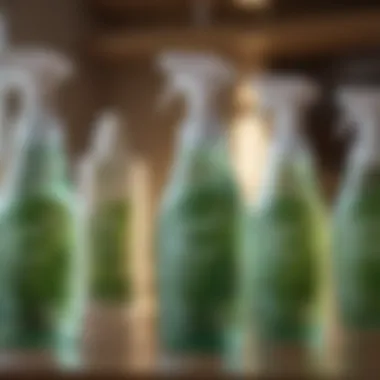
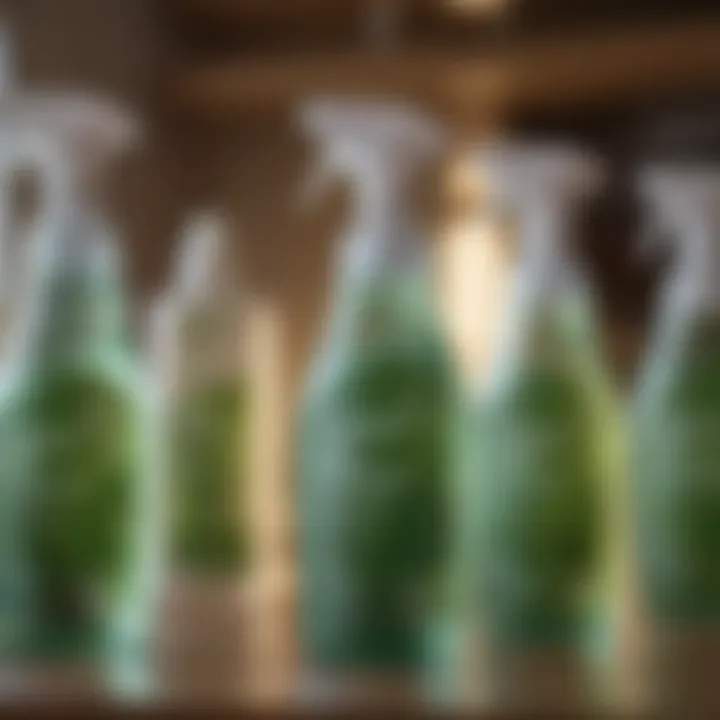
For those inclined towards eco-friendly solutions, natural disinfectants can be an effective alternative. These can include vinegar, essential oils, and baking soda. While they tend to have milder antibacterial properties than conventional disinfectants, they can still play a role in maintaining cleanliness.
- Common Options: White vinegar and tea tree oil.
- Effectiveness: Best for light disinfecting or in combination with other cleaning practices.
"Natural disinfectants can be appealing for those with sensitivities to chemicals or looking to reduce their environmental impact."
In summary, understanding the various types of disinfectants is crucial for making informed cleaning choices in the home. This knowledge allows individuals to select the right product based on the specific environment and cleaning needs they face.
Common Household Disinfectants
Common household disinfectants play a crucial role in ensuring a hygienic environment within the home. Understanding the various types available can substantially benefit homeowners in their cleaning routines. These disinfectants not only assist in killing germs but also help in preventing the spread of infections. Each type of disinfectant has its unique traits and best use scenarios, making it essential for consumers to identify which products suit their needs. Knowing the appropriate applications can save time and enhance overall effectiveness in maintaining a clean household.
The popular choices for household disinfectants include:
- Disinfectant wipes
- Spray disinfectants
- Disinfectant solutions for surfaces
- Hand sanitizers
Each of these options serves distinct purposes and can be effectively incorporated into different cleaning practices.
Disinfectant Wipes
Disinfectant wipes are a convenient option for quick and easy cleaning. They are pre-moistened with an antimicrobial solution and come in a portable format that allows for immediate use. These wipes are particularly valuable for surface cleaning in high-touch areas like doorknobs, light switches, and countertops.
A few benefits include:
- Ease of Use: Just grab a wipe and begin cleaning.
- Portability: Ideal for on-the-go cleaning, perfect for travel or workspaces.
- Effective Against Germs: Many wipes are designed to kill a wide range of bacteria and viruses when left on the surface for the required contact time.
Aside from effectiveness, consideration should be given to environmental impact. Many brands manufacture wipes with biodegradable materials.
Spray Disinfectants
Spray disinfectants are another popular choice for households. They provide a flexible cleaning option and can be used on various surfaces, making them versatile. Users can control the amount of product dispensed, allowing for tailored cleaning.
Advantages include:
- Versatile Applications: Suitable for most surfaces, including fabric, glass, and hard surfaces.
- Quick Cleaning: Fast to apply and can cover larger areas in minimal time.
- Variety of Formulations: Available in different scents and concentrations to satisfy consumer preferences.
Proper usage is crucial with spray disinfectants. Users need to ensure that the product is applied thoroughly and allowed to remain wet for the suggested contact time to maximize germicidal effectiveness.
Disinfectant Solutions for Surfaces
Disinfectant solutions are concentrated formulas that allow consumers to mix solutions based on their specific cleaning needs. This flexibility is beneficial for larger households with diverse cleaning tasks.
Key points include:
- Customizable Strength: Users can adjust the concentration according to the level of disinfection needed, whether for routine cleaning or deeper disinfecting tasks.
- Cost-Effective: Typically, larger bottles of concentrate provide a greater number of applications than pre-mixed products.
- Wide Range of Applications: Works well on flooring, countertops, and even appliances.
Adhering to the manufacturer's guidelines is critical for safety and efficacy.
Hand Sanitizers
Hand sanitizers are vital in maintaining hand hygiene, especially in settings where soap and water are not readily available. They function by killing germs on the skin, making them an essential item to carry.
Some important aspects are:
- Formulations: Most hand sanitizers contain at least 60% alcohol for effective germ elimination.
- Ease of Access: Small bottles can easily fit in zippered bags or even pockets for convenience.
- Infection Control: Especially crucial during flu seasons or viral outbreaks.
Overall, hand sanitizers are best used when soap and water are not accessible, supporting practices that promote hygiene and minimize the potential spread of pathogens.
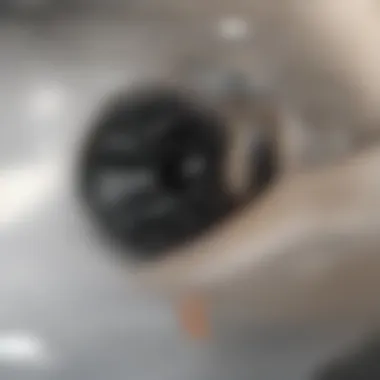
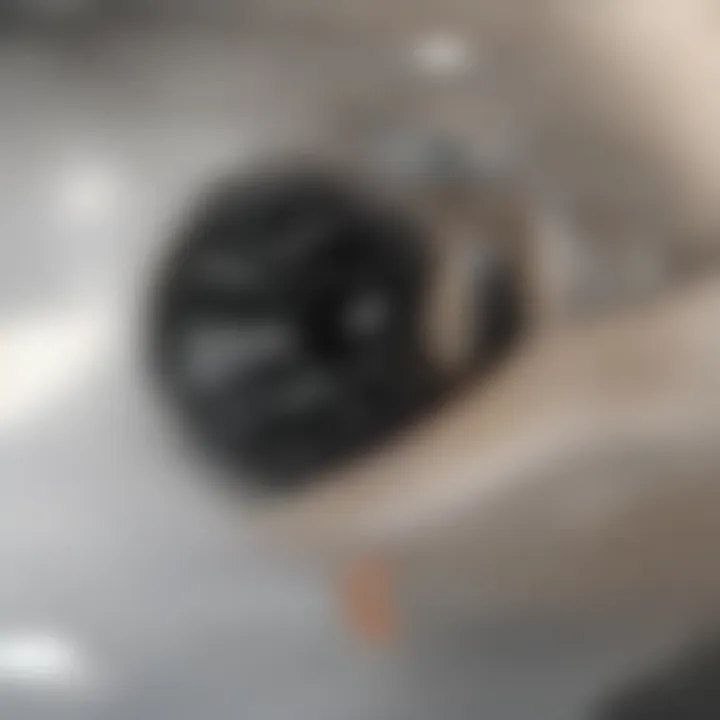
It is essential to review the ingredient list of disinfectants and hand sanitizers to ensure they meet necessary safety standards.
Understanding these common disinfectants can enhance the cleanliness of any home, supporting a healthier living environment.
How to Use Disinfectants Effectively
Understanding how to effectively use disinfectants is crucial for maintaining a clean and safe home. Proper practices can enhance the efficacy of the disinfectants, ensuring harmful microbes are adequately eliminated. We will examine the techniques of application, the significance of contact time, and the key areas in a home that require priority attention during disinfecting.
Correct Application Techniques
Applying disinfectants correctly ensures maximum effectiveness. Here are some key techniques:
- Read the Instructions: Each disinfectant has specific instructions on usage. Pay attention to the recommended dilution if it is a concentrated product. Misusing a disinfectant can reduce its effectiveness or even cause harm.
- Surface Preparation: Before applying a disinfectant, clean the surface to remove dirt and grime. Disinfectants work best on clean surfaces. If there are visible contaminants, they should be removed first.
- Use the Right Tools: Employ clean cloths or mops during application. Make sure to use disposable wipes for single-use applications and avoid cloths that may have residues from other chemicals.
- Spray Distance: If using spray disinfectants, hold the bottle at the specified distance from the surface. Typically, this is around six to eight inches, which allows for even coverage.
- Wipe After Application: If the product instructions state to leave the disinfectant on the surface for some time, do not wipe immediately. If it is to be wiped clean, ensure you use a fresh cloth to avoid cross-contamination.
Contact Time Considerations
Contact time is a vital aspect in the disinfection process. It refers to the duration that the surface must remain wet with the disinfectant for it to be effective. Here are some important points:
- Follow Product Directions: Different disinfectants have varying contact times. Some may require only a minute, while others could need ten minutes for optimal effectiveness.
- Don’t Rush the Process: Ensuring the disinfectant stays wet for the required time is crucial. If it dries out too soon, it may not kill the organisms effectively.
- Environmental Factors: Humidity and temperature influence contact time. In hot, dry environments, a disinfectant can evaporate quickly, reducing its efficacy.
- Multiple Applications: If the area is heavily soiled or used frequently, consider reapplying the disinfectant to maintain cleanliness and reduce microbial loads.
Areas to Prioritize in Your Home
Some areas in your home are more prone to germs and require more attention. Prioritizing these will enhance your overall safety and hygiene:
- Kitchen Surfaces: Regularly disinfect countertops, cutting boards, and kitchen utensils. These areas come into contact with food and are breeding grounds for bacteria.
- Bathrooms: Toilets, faucets, and sinks are hotspots for germs. Pay close attention to disinfecting these areas.
- High-Touch Surfaces: Light switches, doorknobs, remote controls, and phones should be disinfected frequently, as they catch numerous germs from regular use.
- Living Areas: Sofas and shared spaces require attention as they can harbor bacteria from various activities.
"Regular disinfection of high-touch areas in your home can significantly reduce the risk of illness."
Safety Measures and Precautions
Ensuring safety while using disinfectants is crucial for both health and effectiveness. Disinfectants, while effective at killing germs and bacteria, can also pose risks if misuse occurs. Understanding and implementing proper safety measures can prevent health hazards and enhance the value of the disinfecting process. This section covers essential recommendations for protective gear, ventilation, and the appropriate storage and handling of disinfectants.
Protective Gear Recommendations
When applying disinfectants, wearing suitable protective gear is important. This prevents direct contact with the skin and reduces the risk of inhalation of harmful fumes. Consider the following items:
- Gloves: Latex or nitrile gloves help protect the skin from irritation or chemical burns.
- Masks: Depending on the disinfectant used, a mask can prevent inhalation of potent vapors.
- Goggles: Eye protection is necessary, especially when handling concentrated solutions that may splatter.
It is advised to wear long sleeves and closed-toe shoes to minimize skin exposure. Proper gear is a simple yet effective method to ensure safety during the disinfecting process.
Proper Ventilation While Disinfecting
Adequate ventilation is essential when using disinfectants. Poor air circulation can lead to a buildup of fumes, which can be hazardous. Open windows and turn on fans to facilitate airflow in the area being disinfected. Here are some tips for ensuring proper ventilation:
- Open Windows and Doors: This will allow fresh air to circulate, helping disperse any toxic fumes.
- Use Exhaust Fans: If possible, run exhaust fans in the room to pull out contaminated air.
- Limit Occupancy: Keep others away from the area during the disinfection process, particularly children and pets.
Good ventilation not only enhances safety but also increases the efficiency of the disinfectant, allowing it to work effectively in the intended space.
Storage and Handling Guidelines
Storing and handling disinfectants properly is key to preventing accidents. These substances are often flammable or may degrade over time if exposed to unsuitable conditions. Follow these storage tips:
- Store in Original Containers: Always keep disinfectants in their original packaging to prevent confusion about contents.
- Keep Away from Heat Sources: Store disinfectants away from heat, flames, and direct sunlight to avoid unintended reactions.
- Child-Proof Storage: Ensure disinfectants are kept in cabinets that are out of reach of children to prevent accidental ingestion.
Handle disinfectants with care. Always read labels before using and follow any specific storage recommendations to maintain their integrity and effectiveness.
"Safety first is safety always."
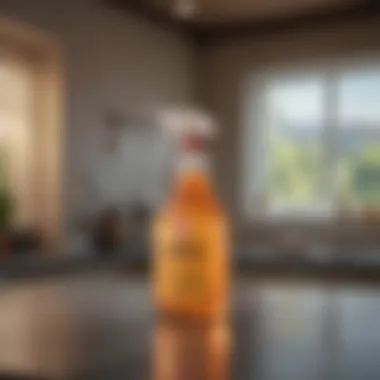
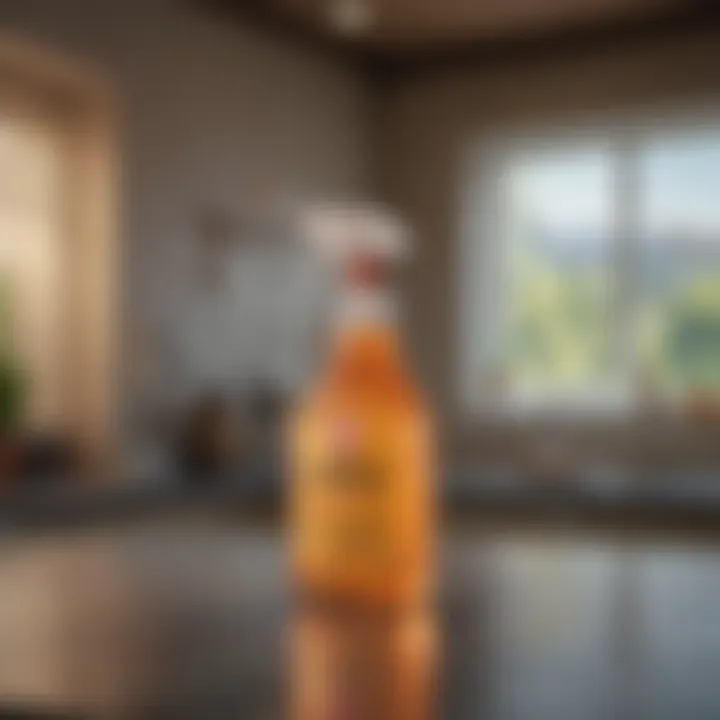
By implementing these safety measures and precautions, the use of disinfectants can be effective and secure. Understanding the importance of protective gear, ventilation, and storage can lead to smarter cleaning practices and a safer home environment.
Eco-Friendly Disinfectant Alternatives
In recent years, the desire for eco-friendly disinfectants has grown. This shift stems from an increasing awareness of the hazards posed by conventional chemical disinfectants. Many traditional products can contribute to toxicity in the environment and health risks for people and pets. Consequently, opting for eco-friendly alternatives makes sense for those who prioritize sustainability and safety in their homes. These alternatives reduce chemical exposure and minimize environmental impact, making them an appealing choice for many.
Homemade Disinfectant Recipes
Creating homemade disinfectant solutions is an easy and cost-effective way to ensure cleanliness without harsh chemicals. Simple recipes often involve common ingredients. These include white vinegar, hydrogen peroxide, and essential oils, which possess natural antimicrobial properties.
Here are a few recipes:
- Vinegar and Water Solution: Mix equal parts of distilled white vinegar and water. This solution is effective for kitchens and bathrooms, especially on counters and sinks.
- Hydrogen Peroxide Spray: Combine 1 cup of 3% hydrogen peroxide with 1 cup of water in a spray bottle. This spray is effective for disinfecting surfaces and can kill a broad range of germs.
- Essential Oil Disinfectant: Add 10-15 drops of tea tree oil or lavender oil to a mixture of 1 cup of water and 1 cup of vinegar. This not only helps in sanitizing but also leaves a pleasant fragrance.
Using these homemade solutions can not only disinfect your environment but also reduce reliance on commercial products that might contain harmful chemicals.
Brands Focused on Sustainability
Many companies today are dedicated to producing disinfectants that align with eco-friendly principles. The focus is on using plant-based ingredients, utilizing biodegradable packaging, and engaging in sustainable production practices. Brands such as Seventh Generation, Mrs. Meyer's Clean Day, and Method are notable examples in this area.
These brands typically offer a variety of products, including all-purpose cleaners, wipes, and sprays, specifically designed to be effective yet gentle on the environment. Consumers should look for labels that emphasize
- Plant-Based Ingredients
- Biodegradable Formulas
- Cruelty-Free Testing
When selecting eco-friendly disinfectants, paying attention to certifications can ensure that products meet stringent sustainability criteria. It promotes better health for the home and the planet.
Regulatory Standards and Compliance
Understanding regulatory standards is crucial in the domain of disinfectants. These standards ensure that products meet specific criteria for safety and effectiveness. Without proper regulations, consumers could misuse products, leading to health risks and ineffective cleaning. The importance of this section lies in guiding homeowners to select disinfectants that are compliant with regulatory requirements. By making informed choices, one can enhance both safety and efficacy in their disinfecting routines.
Understanding EPA Regulations
The Environmental Protection Agency (EPA) plays a vital role in the oversight of disinfectants used in homes. The agency evaluates various disinfectant products to ensure they not only work effectively against pathogens but are also safe for human health and the environment. The EPA reviews data on active ingredients, efficacy trials, and potential environmental impacts before approving a product for public use.
For instance, when a disinfectant is registered with the EPA, it means that the product has met stringent criteria. Consumers can verify if a product is EPA-registered by checking the label, where the registration number is usually displayed. This registration provides assurance that the disinfectant has undergone rigorous testing and has been deemed effective for its intended use. Additionally, regulations may change over time based on new research, so staying updated is also important.
Certification Labels to Look For
When shopping for disinfectants, identifying certification labels can be quite beneficial. Here are some key labels to be aware of:
- EPA Registration Number: This proves that the product is registered under EPA guidelines.
- National Sanitation Foundation (NSF) Certification: Indicates that the disinfectant meets strict public health and safety standards.
- Green Seal Certification: This label shows that a product is environmentally friendly and meets specific sustainability criteria.
It is important for consumers to be educated about these labels, as they serve as indicators of safety and effectiveness. Choosing products with credible certifications can lead to better protection for your home and health.
By recognizing these elements, individuals can make informed decisions about the disinfectants they choose to use in their homes.
Culmination and Best Practices
In the discourse surrounding home hygiene, the value of disinfectants stands at the forefront. This article encapsulates crucial insights about various disinfectant types, their applications, and the importance of a comprehensive cleaning protocol. A proper understanding of disinfectants directly contributes to maintaining a safer and healthier home environment.
Disinfectants are not merely cleaning agents; they play a pivotal role in destroying pathogens that can lead to illnesses. The integration of effective disinfectants in your cleaning routine directly affects the overall health of individuals residing in the space. By familiarizing oneself with diverse disinfectant options and their specific uses, one can significantly enhance home hygiene.
Summary of Key Points
- Disinfectants serve to eliminate harmful germs and bacteria.
- There exists a clear distinction between cleaning and disinfecting that must be understood for effective sanitation.
- Different types of disinfectants, such as bleach, alcohol-based solutions, and eco-friendly options, cater to various cleaning needs.
- Safety measures, including proper use and ventilation, are essential to ensure health during disinfection.
- Developing a consistent cleaning routine can elevate hygiene practices within the home.
Creating a Disinfecting Routine
Establishing a regular disinfecting routine is essential for maintaining health and hygiene at home. Here are some practices to consider when setting up this routine:
- Identify High-Touch Areas: Focus on commonly used surfaces like doorknobs, light switches, and countertops. These areas are more susceptible to contamination and require frequent disinfecting.
- Segment Tasks: Break the routine into manageable tasks. For instance, designate specific days for disinfecting rooms like kitchens, bathrooms, and living areas. This approach prevents the process from becoming overwhelming.
- Use Appropriate Disinfectants: Select disinfectants that correspond with the surfaces you are sanitizing. For example, it is important to use bleach solutions on bathroom surfaces but not on wood.
- Prioritize Contact Time: Ensure that disinfectants remain on surfaces for the recommended contact time for optimal efficacy. This time varies based on the product and the pathogens you are aiming to eliminate.
- Maintain Documentation: Keeping a log can help monitor when areas were last sanitized, promoting accountability and consistency.
Regular disinfecting is not just a measure; it is a necessity for sustaining a safe living environment.
In summary, the importance of understanding disinfectants cannot be understated. A conscientious approach to using disinfectants, integrated within a well-structured routine, will significantly improve cleanliness and health in your home.







